| Main index | Other Papers index | About author |
Julian D. A. Wiseman
Contents: El Greco, The hypothesis, and the question, The pictures, Request for help.
Publication history: only here. Usual disclaimer and copyright terms apply.
Update (August 2011): Professor Phillip Beales has suggested Cornelia de Lange Syndrome (see below).
The first draft of this paper, dated December 2006, hypothesised that El Greco was inspired by a child with Williams Syndrome. (WS children have distinctively odd faces, are sociable and conversational, also musical, though in other ways have mental handicaps, sometimes severe.) However, dysmorphology experts disagreed with the Williams Syndrome hypothesis.
• Dr Lakshmi Mehta (Division of Medical Genetics, Schneider Children’s Hospital at North Shore) said “I don’t think that is a Williams syndrome face. The nose is unusual and the Christ Child (which is the best shot) has a peaked anterior hairline and a small jaw. However the nose is finer without an upturned tip as seen in Williams. The mouth is also not characteristic. The back of the head (seen in many of the shots), is somewhat flattened, and you can see the ears are long, somewhat pointed. However, I do not think … Williams looking at those pictures.”
• Dr Laurie Sadler (Division of Genetics, Women & Children’s Hospital of Buffalo) concurred: “El Greco’s subjects do not have Williams syndrome.”
• Dr Ian Young (University Hospitals of Leicester): “I agree that some of the individuals portrayed have unusual features, notably apparent microcephaly/brachycephaly, but I don’t find them suggestive of Williams syndrome. The lower face is very characteristic in Williams syndrome children and none of these paintings shows these features.”
The artist known as El Greco (the Greek) was born in Crete in 1541 as Doménicos Theotocópoulos (Δομήνικος Θεοτοκόπουλος). He studied in Venice, and in 1570 moved to Rome, and from there to Toledo in 1577 where he stayed until his death in 1614. Wikipedia says of El Greco that his dramatic and expressionistic style was met with puzzlement by his contemporaries but found appreciation in the 20th century. There is a distinctive feature of many of the faces painted by El Greco, documented here: those faces may well be modelled on a child with some specific malformation. But which?
Below are extracts from various El Greco pictures, showing a head with a consistent dysmorphology. It is hypothesised that El Greco knew, at a formative stage in his life, a child with some type of malformation. But the author doesn’t know which of the many possible conditions it is. So help is asked of paediatricians expert in this field: please, send candidate diagnoses to the author.
El Greco, Christ Cleansing the Temple, probably before 1570, National Gallery of Art, Washington DC (source). These upturned noses are a leitmotif of El Greco, and are often shown in a pose with the head thrown back. Is that gesture typical of some condition? |
 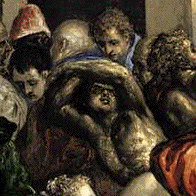 |
El Greco, The Agony in the Garden, about 1590, Toledo Museum of Art (source picture). Enough of this angel can be seen to see that the face isn’t quite right, but not enough to know what’s wrong. |
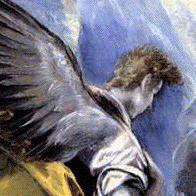 |
El Greco, The Holy Family with Mary Magdalen, about 1590 to 1595, Cleveland Museum of Art (source picture). Dr Lakshmi Mehta (box above) commented on the peaked anterior hairline and small jaw. |
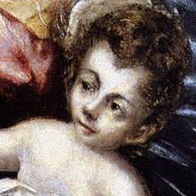 |
El Greco, The Baptism, about 1596 to 1600, Museo del Prado? (source picture). Another flattened back of head. |
 |
El Greco, The Agony in the Garden, about 1600 to 1605, Church of Santa Maria, Andújar (source picture). Again the same ski-slope nose, drawn in the same profile, and twice in the same picture. |
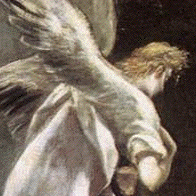 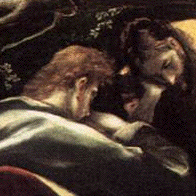 |
El Greco, Christ driving the Traders from the Temple, about 1600, National Gallery, London (source). This picture is dated at least a quarter of a century after the NGA’s Christ Cleansing the Temple: it could be that El Greco has imperfectly remembered his model’s face. |
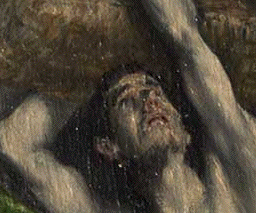 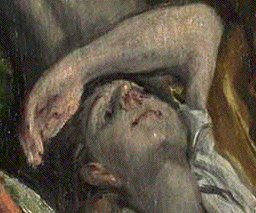 |
El Greco, The Baptism of Christ, about 1608 to 1628, Hospital Tavera, Toledo (source picture). Another upturned head showing the viewer an unusual nose. |
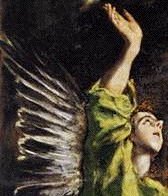 |
El Greco, Laocoön, about 1610 to 1614, National Gallery of Art, Washington DC (source). Longer noses, and less mis-shapen heads: perhaps these were not inspired by the child that inspired the others? |
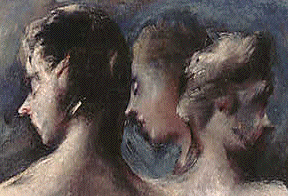 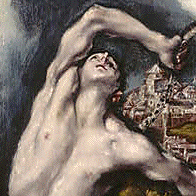 |
El Greco, The Vision of Saint John (56.48), about 1608 to 1614, The Metropolitan Museum of Art (source). Again, the nose is upturned. The chin is small, but not abnormally so. |
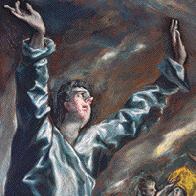 |
Paediatricians and dysmorphology experts of the world, please, tell the author what condition inspired these strange heads?
Julian D. A. Wiseman, January 2007
In August 2011 the BBC published a story Who was Peter the Wild Boy?, about an eighteenth century boy and his recent diagnosis with Pitt-Hopkins Syndrome by Professor Phillip Beales, of the Institute of Child Health.
So the El Greco question was put to Professor Beales, and he answered.
Thanks for contacting me. I also enjoy paintings very much and in particular spotting the “syndrome” the artist might have portrayed. …
In truth, it’s a tricky one even for Peter the Wild Boy but at least the artists were creating portraits. With the old masters (El Greco, Goya etc) there is far more artistic licence and stylisation involved.
That said, one of the pictures you directed me to on your webpage – the young child (boy – third down) is reminiscent of children with Cornelia de Lange syndrome with the arched, thick eyebrows, large irregular ears, long flat philtrum, smooth upper lip and small jaw
Cornelia de Lange Syndrome? That is a splendid hypothesis, which also agrees with that boy’s odd left hand, pictured (and from the same source). However, alas, online sources about Cornelia de Lange Syndrome do not mention the distinctive head-thrown-back gesture.
Professor Beales: Thank you very much indeed.
In March 2020 links to the long-defunct dmoz.org were replaced with links to wikipedia.
| Main index | Top | About author |